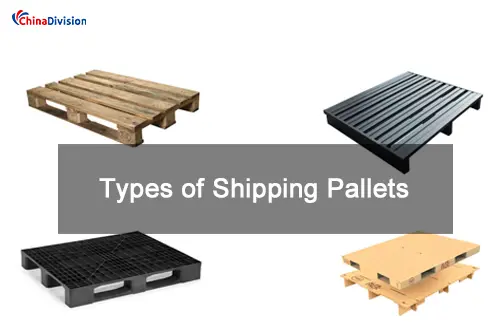How to Reduce Logistics Costs by Choosing Shipping Pallets?
Shipping pallets may seem ordinary, but they are the core tool for improving efficiency and reducing costs. Many practitioners are still confused about the selection of pallets of different sizes and materials, as well as how to optimize costs and improve efficiency through pallets.
Table of Contents
- What is a shipping pallet?
- Common types and size selection of Shipping Pallets
- Wooden pallets vs. plastic pallets vs. metal pallets: How to avoid pitfalls?
- What is the difference between air freight pallets and container pallets?
- How does palletized transport reduce freight costs?
- Key benefits of using Shipping Pallet
- What goods are not suitable for pallet transportation?
- Frequently Asked Questions Quick Answers
- Chinadivision's solution for international logistics fulfillment service providers
As an international fulfillment service provider, Chinadivision combines industry experience to analyze the core value and solutions of air freight pallets for you.
What is a shipping pallet?
A shipping pallet is a flat transport structure used to stably support goods for handling by forklifts, forklifts or other lifting equipment. Pallets are crucial in air transportation because they help to efficiently handle and transport goods and ensure that goods are protected in an orderly manner during transportation.
Common types and size selection of Shipping Pallets
Pallets can be divided into wood, plastic, metal, composite materials, etc. according to the material, and each material corresponds to different application scenarios. For example, wooden pallets are still the most widely used type in the world due to their low cost and strong load-bearing capacity, but they need to be fumigated to meet international quarantine standards; plastic pallets are the first choice for industries such as food and medicine due to their corrosion resistance and recyclability. Plastic pallets have become the mainstream choice in air transport scenarios due to their advantages such as lightweight, corrosion resistance and recyclability.
Size standardization is the core consideration for air transport pallets.
International general pallet sizes include:
Euro pallets
1200mm×1000mm or 1200mm×800mm Euro pallets (such as 1200mm×1000mm specifications) are the mainstream European standard and are suitable for narrow-body cargo aircraft. Because they are suitable for the size of air cargo aircraft, they have become the mainstream choice for air transport pallets.
American pallets
1219mm×1016mm, widely used in air transport because they meet the mainstream container pallet standards
Japanese pallets
1100mm×1100mm, due to size differences, special attention should be paid to the compatibility with cargo plane doors.
Customized size
Flexible design for special goods (such as mechanical equipment).
Wooden pallets vs. plastic pallets vs. metal pallets: How to avoid pitfalls?

Wooden pallets
Low cost (about $15/piece), but require fumigation treatment (ISPM15 standard), otherwise there is a risk of overseas return. Wooden pallets are still widely used due to their low cost and strong load-bearing capacity, but it is necessary to pay attention to whether their moisture-proof and insect-proof treatments meet international transportation standards.
Plastic pallets
No fumigation required, corrosion-resistant (unit price $50-$80), suitable for high-frequency transportation, and light weight can reduce air transportation fuel costs. Plastic pallets (such as blow-molded nine-legged pallets and field-shaped plastic pallets) are more suitable for industries with high hygiene requirements such as food and medicine because of their light weight, corrosion resistance and easy cleaning, and their service life is 5-7 times that of wooden pallets.
Metal pallets
With a load-bearing capacity of over 2000kg, they are suitable for heavy machinery, but the cost is high ($200+) and anti-rust treatment is required. Chemical products should use metal pallets (Steel pallets) or composite pallets (such as plastic wood pallets) to balance cost and efficiency.
Composite pallets
Composite pallets are made of a variety of materials and achieve a balance in weight, strength and durability. Their design is more environmentally friendly and is a good choice for companies that want to reduce their carbon footprint.
What is the difference between air freight pallets and container pallets?
Air freight pallets
Designed for aircraft cargo holds. Usually made of lightweight metals (such as aluminum) and fixed with nets or belts. Commonly used for ULD air freight pallets such as PMC, PAG and PLA.
Container pallets
General pallets used for sea or land transportation. Made of wood, plastic or metal, used in containers.
Choosing the wrong pallet can cause your cargo to be delayed or rejected - especially in international air transport.
How does palletized transport reduce freight costs?
Loading efficiency
Standardized pallets enable cargo aircraft to use up to 90% of their space (only 70% for bulk cargo).
Palletization allows cargo to be loaded and unloaded quickly, reducing labor costs. According to statistics, the use of pallets can increase loading and unloading efficiency by 30%-50%, which is especially suitable for scenarios where frequent loading and unloading is required in air transport.
Labor costs
Pallets are three times more efficient than bulk cargo, and their buffering effect reduces the impact of transport vibrations on cargo.
Hidden benefits
Some airlines offer a 5%-10% freight discount on palletized cargo.
Compliance
Pallets that meet international standards (such as the ISPM15 standard) can avoid additional costs due to size discrepancies.
Key benefits of using Shipping Pallet
Reduce labor and cargo damage costs
By consolidating cargo on pallets, you can reduce the number of manual handling times and reduce the cargo damage rate. For example, after using pallets, the damage rate of goods can be reduced by 30%-50%, thereby reducing the additional costs caused by damage to goods.
Standardization and efficiency
Pallets realize the unitization of goods, which is convenient for forklift loading and unloading, reduces manual handling, and improves efficiency. For example, when transporting electronic products by air, palletization can reduce the damage to goods caused by manual handling and reduce the cost increase caused by wrong or missed shipments.
Pallets make goods unitized, which is convenient for forklifts or hydraulic vehicles to use, which can reduce the number of manual handling times and reduce the damage rate. For example, cargo standardization through palletization can improve air transportation loading and unloading efficiency and reduce vehicle waiting time.
Enhanced safety
Pallets provide a stable foundation for goods, reducing the risk of displacement or falling during transportation. This improves the safety of goods and handling personnel.
What goods are not suitable for pallet transportation?
Bulk frozen goods: easy to melt and deform, need to be transported in special refrigerated containers.
Overweight and overlong goods: single piece side length exceeds 0.8 meters (narrow-body aircraft limit), need to be split for transportation. For example, steel and mechanical equipment may not be transported due to the size limit of the pallet.
Mixed dangerous goods: Dangerous goods of different natures cannot be mixed on the same pallet.
Frequently Asked Questions Quick Answers
Does the air freight pallet require additional packaging?
The pallet itself does not replace the packaging! The goods need to be fixed with waterproof film + wrapping film, and fragile goods need to add corner protection.
How to deal with the billing problem caused by the dead weight of the pallet?
The Chinadivision system automatically calculates the "pallet weight ratio" and recommends lightweight plastic pallets for light goods.
What type of pallet should I use?
Choose wooden, plastic or composite pallets according to your specific needs. Wooden pallets are economical and durable, while plastic pallets are lighter and more durable. Composite pallets have both weight and strength. When making a decision, please consider factors such as cargo weight, hygiene requirements and environmental impact.
Do all air cargo require pallets?
No, not all air cargo requires pallets. Pallets are usually used for bulk goods, fragile items or products that need to be transported stably and safely.
Chinadivision's solution for international logistics fulfillment service providers
At a time when air freight costs are rising, a professional and suitable pallet solution may be the key to reducing costs and increasing efficiency. When choosing a suitable pallet, you need to consider the characteristics of the goods, the means of transportation, and cost-effectiveness. If you need further consultation, please contact Chinadivision and let us use our professional experience to provide a one-stop solution for your air freight palletization.





